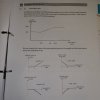K
KMER94
Member
Hi, I'm struggling with the charts in the answers to question 1 on chapter 15.
Question states "A building society issues a one year bond that entitles the holder to the return on a weighted average share index ABC500 up to a maximum 30% growth over the next year. The bond has a guaranteed minimum level of return so that investors receive at least x% of their initial investment back. Investors cannot redeem their bonds prior to the end of the year.
(i) explain how the building society can use a combination of call and put options to prevent making a loss on these bonds?"
The answers then shows charts to recreate the payoff of the bond which supposedly should be a long put and a short call but I can't see how that recreates the payoff as I think it looks more like a long call and a short put...??
Question states "A building society issues a one year bond that entitles the holder to the return on a weighted average share index ABC500 up to a maximum 30% growth over the next year. The bond has a guaranteed minimum level of return so that investors receive at least x% of their initial investment back. Investors cannot redeem their bonds prior to the end of the year.
(i) explain how the building society can use a combination of call and put options to prevent making a loss on these bonds?"
The answers then shows charts to recreate the payoff of the bond which supposedly should be a long put and a short call but I can't see how that recreates the payoff as I think it looks more like a long call and a short put...??

